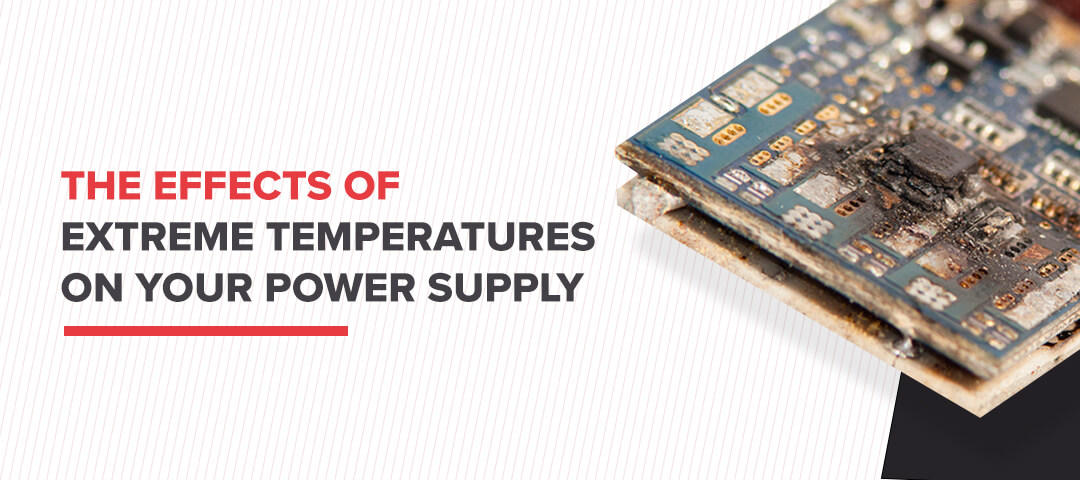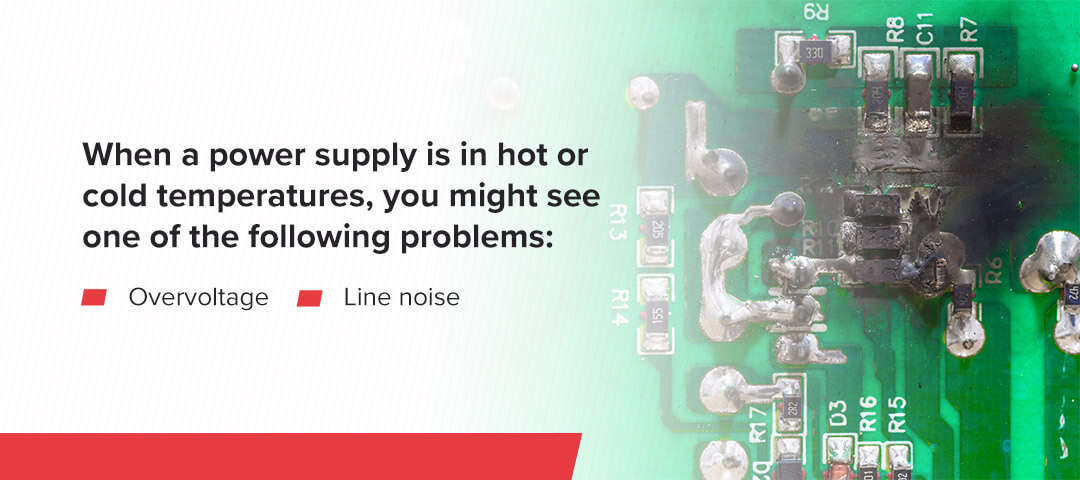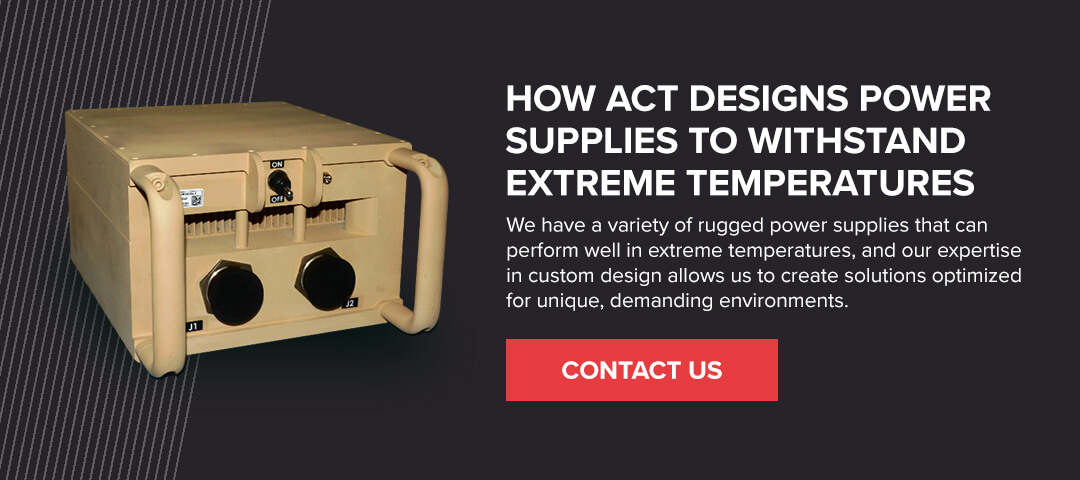
Like all electronics, power supplies can’t function in every environment. Extreme heat and cold can impact your power supply’s functionality. High temperatures might lead to thermal runaway, reduce the equipment’s lifespan, and reduce component reliability, while cold temperatures can cause a variety of effects on performance and product lifespan.
The operating environment of a power supply is heavily influenced by usage and design considerations, like ventilation, air flow, and heat sinks that affect reliability. By understanding the effects of extreme temperatures, you can better choose the right power supply for your application and keep it working as long as possible.
Quick Navigation:
- How Extreme Temperature Affects Your Power Supplies
- Designing Power Supplies to Stand the Test of Extreme Temperatures
- How ACT Designs Power Supplies to Withstand Extreme Temperatures
How Extreme Temperature Affects Your Power Supplies
Extreme temperatures are the enemy of efficiency in power supplies. Both high and low temperatures can cause problems, but heat is often the primary concern because electrical components generate heat and heat shortens the component’s lifespan. The effects of cold temperatures are more performance-related and less influential on device health.

When a power supply is in hot or cold temperatures, you might see one of the following problems:
- Overvoltage: An overvoltage occurs if the incoming voltage exceeds nominal voltage limits. It can cause malfunctions, component damage, and total shutdowns.
- Line noise: Random electrical impulses or fluctuations that move along a standard alternating current (AC) are called line noise. The intensity can vary, but line noise can cause additional stress on components, which in turn can compromise the reliability of the power supply.
High Temperatures
An overheating power supply can experience a range of problems that affect how long it lasts and present different risks. High operating temperatures can:
- Reduce a power supply’s lifespan: Components that consistently run beyond what they were rated for decrease the life of the power supply. Chemical processes accelerate and mechanical connections can even loosen. The longer a component is operated at high heat, the more elevated temperatures can reduce its lifespan.
- Reduce the load of a power supply: Power supplies typically have specified loads according to an ambient temperature range. Move outside that range, and the load can derate to a much smaller number. The rated operating temperature of a power supply is necessary for optimizing performance.
- Increase the risk of failures and malfunctions: Exceeding operating temperatures can also hurt the equipment’s reliability.
Extremely high temperatures can be especially challenging to address because electronics create heat during regular operation, contributing to higher ambient temperatures.
Low Temperatures
Electronics generally like the cold, but if the temperature drops too low, it can still cause problems. Low temperatures are more likely to affect performance than a power supply’s lifespan. Low power supply temperatures can:
- Increase the output ripple: The cold can add noise into the system and cause the output voltage ripple to increase, which can waste power.
- Prevent fully regulated outputs: Low temperatures also affect the power supply’s ability to completely regulate its output.
- Prevent proper startups: Below a certain ambient temperature, component characteristics change. If electrical characteristics change drastically enough, the power supply may not start at cold temperatures.
- Increase the risk of electrolytic capacitor seal failure: Extreme cold can cause electrolytic capacitors to fail, a catastrophic failure for the component.
Designing Power Supplies to Stand the Test of Extreme Temperatures
Although extreme temperatures can hurt a power supply, some design considerations can help mitigate or prevent damage. When designing power supplies, manufacturers consider the following factors.
Operating Environment
Designers need to consider where the power supply will be used. Will it be in a hot military environment where dust and dirt can clog up a vent, or will it be moderately used in someone’s lab at a consistent room temperature? Designers must think about whether a power supply will need additional temperature mitigation features.
The device’s operating environment will also determine whether the power supply will need to be sealed, such as preventing water and dust ingress, or if it can be vented to improve airflow.
Some applications need to stand up to a wide range of operating temperatures, particularly those used outdoors. Take traffic control, for instance. Power supplies need to be housed outdoors, where the extreme heat of the summer and the extreme cold in the winter will both be in play.
Heat Sources
Power supplies heat themselves up at different rates and intensities, and environmental influences will impact how quickly a power supply is exposed to high temperatures. Designers have to factor in the additional heat of nearby equipment, self-heating from high loads, and radiant heat such as solar energy on an enclosure.
Cooling Methods
Most power supplies will need some kind of cooling mechanism in place, which can include:
- Convection: Convection cooling uses free airflow to cool the device and can be as simple as fins on the power supply housing.
- Forced air cooling: Forced air cooling typically adds an external fan to the power supply or uses one nearby.
- Conduction: Conduction cooling transfers heat away from the power supply with a heat sink or thermal plate in the housing or frame.
Touch Temperature
If an external power supply could be touched by an operator, the designer will also need to consider the housing’s heat to ensure it doesn’t burn the user or pose a fire hazard.
Orientation
The orientation of a power supply can also affect heat buildup. Since hot air rises, a vertically mounted power supply tends to transfer heat to other components, but a horizontal power supply allows the air to move more easily via cooling methods.
Temperature Monitoring
For some applications, you can use power supply temperature monitoring solutions that will alert you to out-of-range ambient and operating temperatures. They allow you to intervene to maximize component life and performance.
How ACT Designs Power Supplies to Withstand Extreme Temperatures
At Advanced Conversion Technology, we design and manufacture power supplies for all environments. We have a variety of rugged power supplies that can perform well in extreme temperatures, and our expertise in custom design allows us to create solutions optimized for unique, demanding environments.
We’re a trusted source for military clients who require reliable, rugged power supplies. Whether you need a power supply that stands up to high heat or that must stay operational during wide temperature ranges, our knowledgeable team can help. With AS9100 certification for our quality management system and adherence to many other quality standards, ACT meets and exceeds even the strictest of demands.
Browse our power supplies online, or reach out to us today with any questions or to discuss custom solutions.
